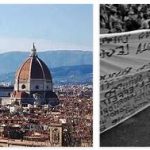In Sicily, the civilization of Stentinello, until now considered exclusive to the eastern regions (Syracusano and the Etna area), has been identified in the Trapani area (Paceco), thus demonstrating its extension over the whole island. The impressed ceramic shows it came out of the same lineage of the older cultures of Liguria, Puglia, etc., although it certainly lasted longer than these, until it received the contributions of the Balkan-influenced cultures of southern Adriatic Italy (painted ceramic of Megara Iblea, clay idols, etc.). At the end of the age of Stentinello, all of Sicily, but particularly the north-eastern cusp and the Aeolian archipelago, must have been strongly influenced by the Apulian-Materan cultures, manifested through a large export of red and painted pottery. whose products characterize the station and necropolis of Marmo di Paternò, illustrated by Italy Cafici, the stations of Lipari (Diana) and Calcara di Panarea, etc.; but they sporadically reach as far as Syracusano (Matrensa), Caltagirone (Bersaglio) and Palermo (M. Pellegrino). The grafting of this new current on the old Stentinellian stock, to which are added perhaps close relations with Iberia, probably leads to the rise of the culture of S. Cono (Licodia Eubea) and Piano Notaro (Gela), present in many places of eastern Sicily (Trefontane di Paternò, Grotta di Calafarina, Bersaglio di Caltagirone, etc.) and even more widespread in the west (culture type Conca d’Oro, illustrated by Italy Marconi Bovio). It is characterized by particular ceramic forms, decorated with curvilinear grooves flanked by dots or with graffiti after firing and sometimes bearing the first local attempts at a painted decoration. In the lithic industry, concave-based freccioline dominate. But Sicily was at a certain moment attracted to the sphere of the Aegean cultures of the Middle Helladic, under the influence of which the Castelluccio and Serraferlicchio cultures blossomed on the eastern and southern coasts. It is perhaps a true colonization movement. The two cultures of Castelluccio (Siracusano) and of Serraferlicchio (Agrigento) seem to be two parallel and independent offshoots of Helladic cultures. The characters of the mother culture are segregated into the two derived cultures, each of which inherits elements that the other does not possess. A painted ceramic is common to both, identical in technique, different in the decorative style as well as in the shapes it decorates. It is associated with Serraferlicchio with a glossy monochrome ceramic of bright red color and with a black buccheroid, absent in Castelluccio. These three classes of ceramics seem to correspond to the three classes of Helladic ceramics (Mattmalerei, Urfirniss, Minia). From the Helladic horizon also derive many of the vascular forms and above all the type of oven tombs, which now appears for the first time in Sicily. Painted ceramic, sometimes in three colors, similar to the types of Serraferlicchio has been reported in the Grotta del Vecchiuzzo (Petralia Sottana), in Termini Imerese, in Isnello, etc. The target of Caltagirone seems to be part of the same horizon. But the culture of Castelluccio, which first developed in the south-eastern cusp of the island,faciesparticular (Monte Sara, Monte Aperto, Monte d’Oro, etc.). The old indigenous culture (S. Cono) does not disappear, but retreats in the face of the progress of cultures of Helladic influence from which some elements derive (oven and well tombs, etc.), and has a late flowering in Palermo, where it reaches to have contact with the Iberian cultures from which the characteristic bell-shaped vase imported (Villafrati, Carini, Torrebigini), under whose influence the Moarda culture developed, characterized by a richly decorated ceramic in bands in the same technique as that. Its products are often associated with painted Serraferlicchio ceramics, which, on the other hand, in the decorative style sometimes reveals undoubted influences of the bell-shaped vase. L’ influence of cultures of Helladic origin dates back to the peninsula and we have found it evident in the necropolis of Paestum. In Sicily the lithic industry of Campania found a luxuriant development, still foreign to Stentinello, but dominant in Serior cultures, of which vast lithic workshops exist in the Iblei (S. Cono, Calaforno, Scalona, etc.). The Aeolian islands also reached a particular prosperity, fueled by the obsidian trade which, collected in Lipari and processed in the villages of the islands (Panarea, Filicudi, Salina), was then widely exported.
Age of metals. – Less decisive has been the progress of the studies for the age of metals, which is already much better known. The greatest contribution was made by the definition of the characters and expansion of the “Polada” civilization due to P. Laviosa Zambotti. This culture that flourishes in eastern Lombardy and Veneto, but whose influence is felt throughout the Po Valley, southern France and Catalonia, develops through two phases, one closely connected to the civilization of Remedello and therefore having its roots in the early dawn of the Metal Age, the second parallel to the Aenean Po culture of Castione dei Marchesi (formerly called “terramaricola”). This in turn is preceded by another faciescultural (Lagazzi di Vho), which can be synchronized with Polada Italy The recently excavated stilts of Fimon, Barche di Solferino and above all the one, very important for its vastness, conservation and discoveries, of Molina di Ledro belong to the civilization of Polada Italy
According to ELAINEQHO, the research of Calzoni on the Cetona Mountain (stations of Belverde, with typical “Apennine” ceramics decorated with carving, and of Casa Carletti, later forms now preluding to the Iron Age, contributed to the knowledge of the Apennine culture of peninsular Italy. ; both horizons at the Devil’s Den in Parrano-Orvieto), by F. Rittatore in Grotta Misa (Ischia di Castro, Viterbo), by L. Cardini at the Grotta dello Scoglietto (Monti dell’Uccellino) and those by G. Buchner in Ischia (where the Apennine intaglio pottery is stratigraphically associated with Mycenaean pottery of the late Minoan III).
For the Iron Age the discoveries have not significantly changed the panorama already known for the peninsula: our examination will therefore be limited to the peripheral regions, whose knowledge had remained less in-depth until recently. The evolution of the Golasecca civilization has been particularly studied: from Barocelli in the major necropolises of the Novara area (Ameno, Castelletto Ticino, S. Bernardino, di Briona, etc.), from Crivelli in the Canton of Ticino. Attention was paid for the first time, as well as to the tombs, to the settlements of this age (Alba, Bric Berciassa near Borgo S. Dalmazzo, Monte Mesma di Ameno, Merlotitt, etc.). Maritime Liguria received particular light, which at this time was a marginal area in the Golasecca civilization and presents conditions of singular backwardness. The excavation of a built-up area in Rossiglione revealed the persistence of the lithic industry, perhaps beyond the 5th-4th century. to. C., and the excavation of the Arene Candide that of the dwelling in the cavenne (see Tanassa di Toirano, Bergeggi, etc.). The persistence of the samecultural facies in some castellieri of the Riviera di Levante (Pignone, Framura, etc.) demonstrates the primitive conditions of the region still at the time of the Roman-Ligurian wars (end of the 3rd century BC).
The cultures of Trentino and Alto Adige have been the subject of extensive studies by P. Laviosa Zambotti, who has highlighted the cultural dependence of that region on the Po Valley and the phenomena of cultural stagnation that have occurred there.








